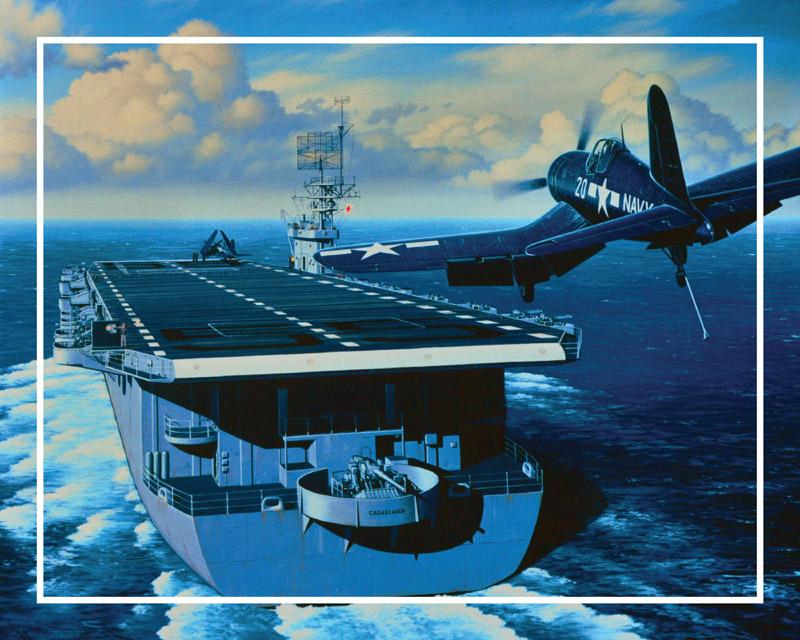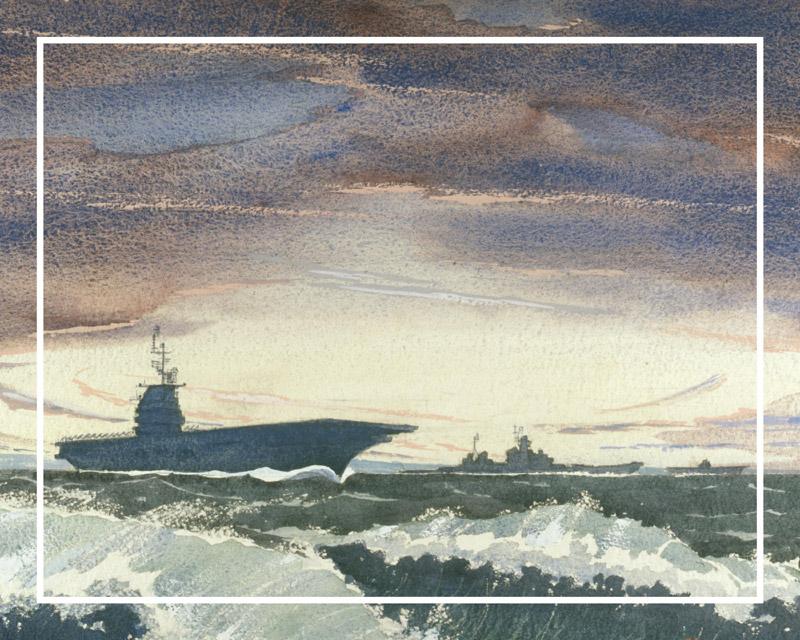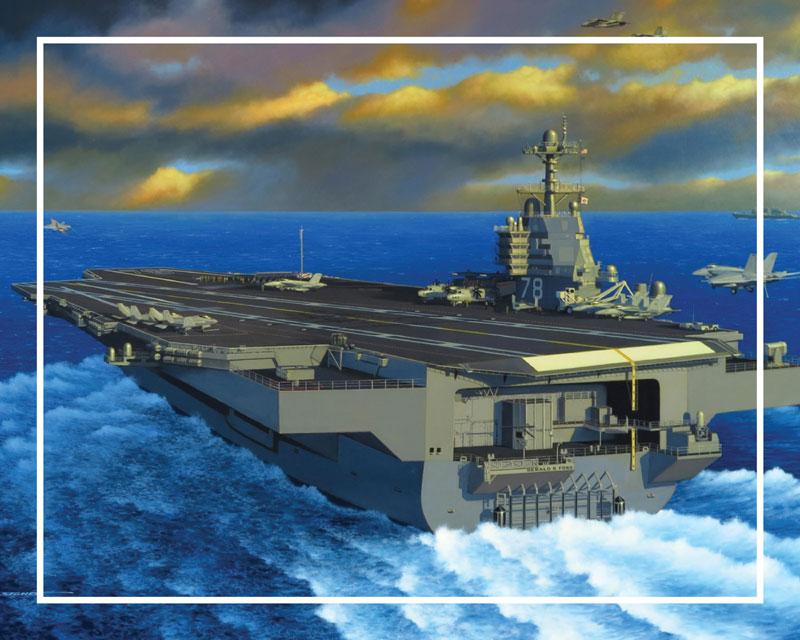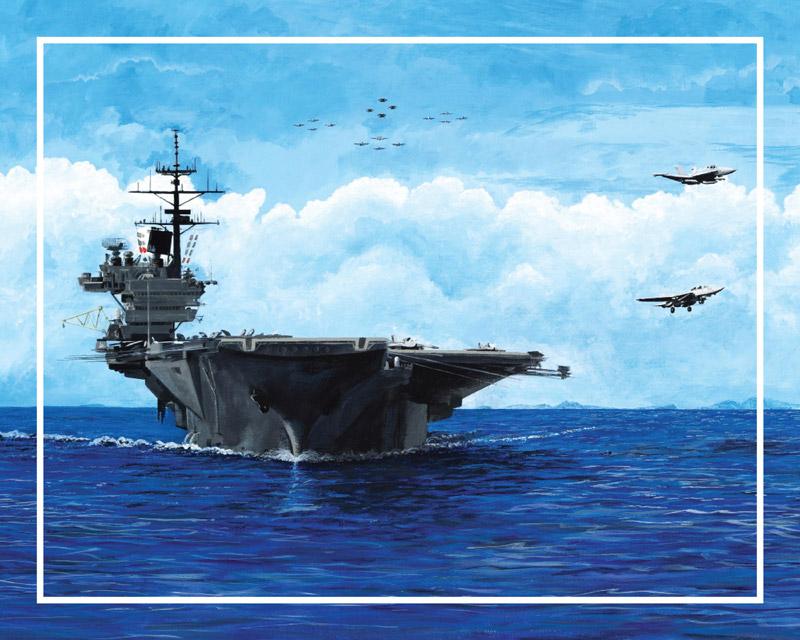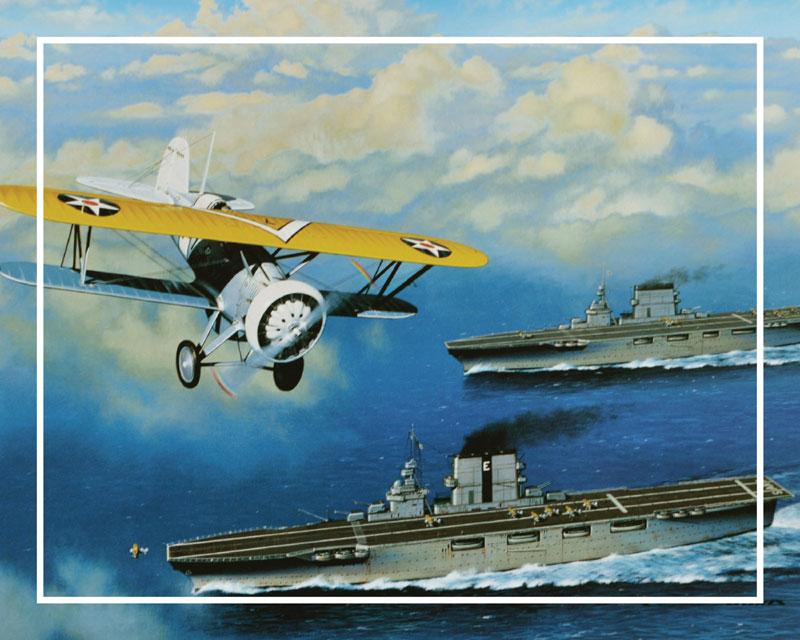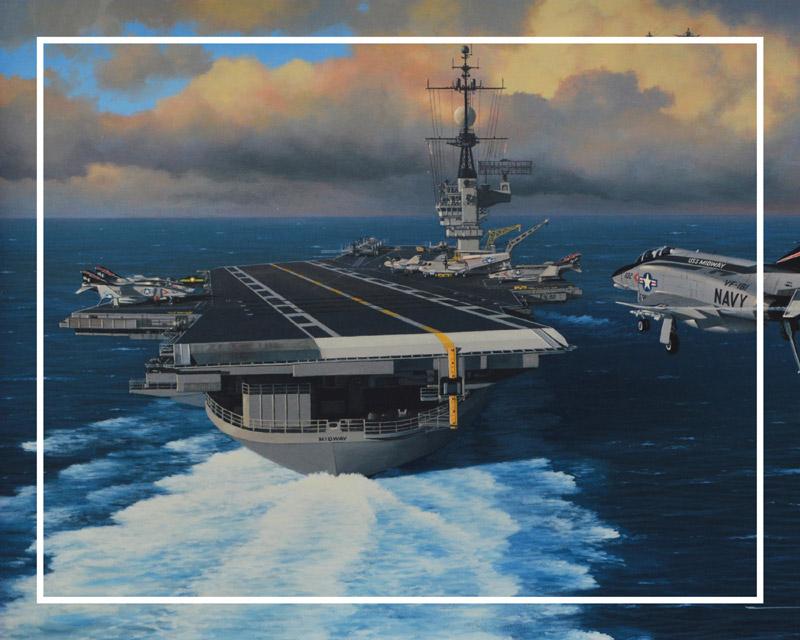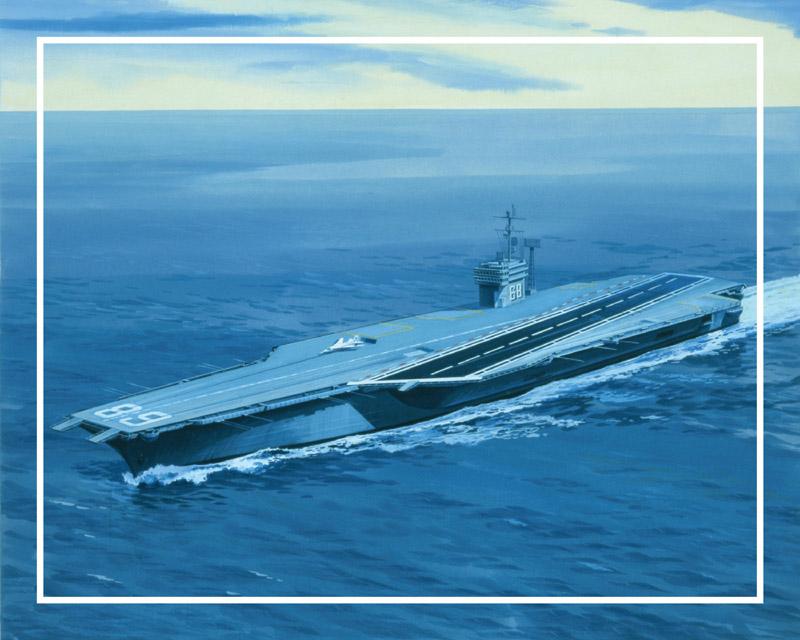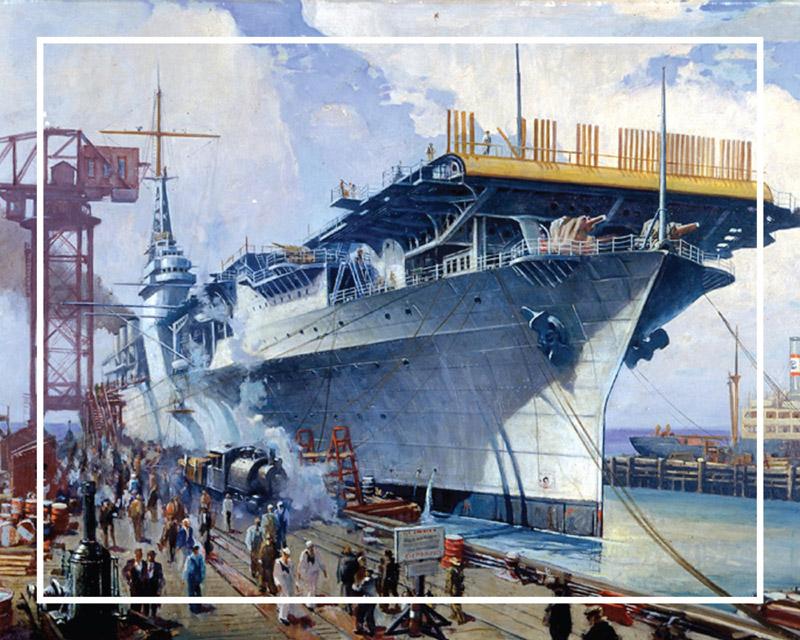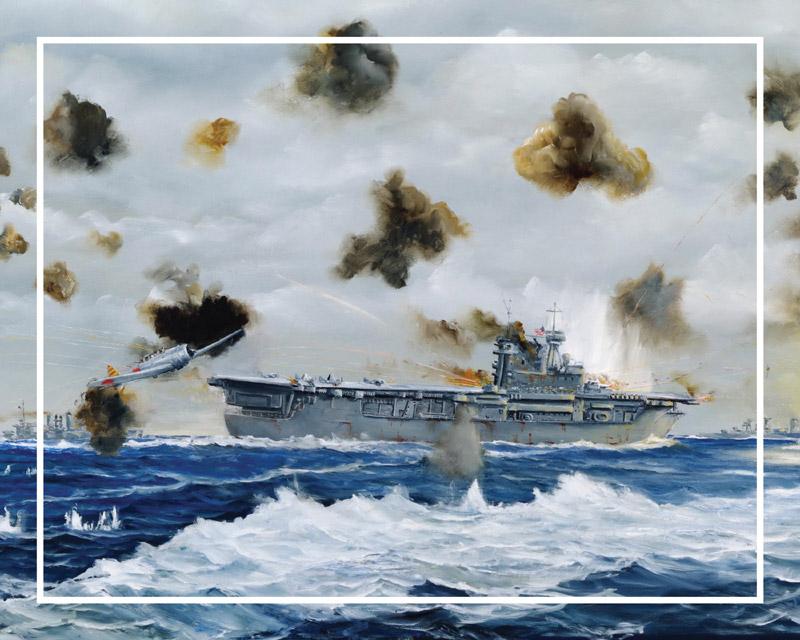-
In 1920, the U.S. Navy converted a collier (a ship used to transport coal) into America's very first aircraft carrier - the USS Langley (CV 1). She was the only ship of her class and becam...Read more
In 1920, the U.S. Navy converted a collier (a ship used to transport coal) into America's very first aircraft carrier - the USS Langley (CV 1). She was the only ship of her class and became an experimental platform for naval aviation pioneers. Nicknamed the "Covered Wagon" for her flush flight deck carried over a steel framework, the USS Langley served the Navy in numerous roles until sunk by the Japanese in 1942.
-
During World War II, American industry produced a staggering 122 escort carriers in six different classes. While some "baby flattops" were built on merchant or tanker hulls, others were built from ...Read more
During World War II, American industry produced a staggering 122 escort carriers in six different classes. While some "baby flattops" were built on merchant or tanker hulls, others were built from the keel up as carriers. The most numerous were the Casablanca-class carriers manufactured by industrialist Henry Kaiser. Though the ships proved slow by navy standards, they did help turn the tide against German U-boats in the Atlantic and helped bring more U.S. planes into combat in the Pacific.
-
During World War II, America embarked on a more aggressive carrier program and the Essex-class carriers became the primary fleet carriers of the period. The product of nearly two decades o...Read more
During World War II, America embarked on a more aggressive carrier program and the Essex-class carriers became the primary fleet carriers of the period. The product of nearly two decades of carrier design and deployment, the Essex class displaced about 30,000 tons, and could accommodate an air wing of up to 100 planes. Twenty-four were constructed during the war, and many remained in service for decades through structural upgrades and modernizations.
-
The recent christening of the USS Gerald R. Ford (CVN 78) unveiled the new generation of super carrier. She is the first of three planned for the new Ford-class. This all new rede...Read more
The recent christening of the USS Gerald R. Ford (CVN 78) unveiled the new generation of super carrier. She is the first of three planned for the new Ford-class. This all new redesign incorporates the new A1B nuclear reactor, which generates three-times the power of the Nimitz-class A4W. The reactor will power the new Electromagnetic Aircraft Launch System (or EMALS) and will also replace other traditionally-assigned hydraulic with electromagnetic systems, scaling back the amount of crew needed for the ship. The Ford will accommodate up to 90 aircraft and will be among the first wave of navy ships to utilize stealth technology.
-
The commissioning of the USS Forrestal (CV 59) in 1955 ushered in America's first class of super carriers. Eight ships constructed through the 1950s and 1960s were designated Forrestal or ...Read more
The commissioning of the USS Forrestal (CV 59) in 1955 ushered in America's first class of super carriers. Eight ships constructed through the 1950s and 1960s were designated Forrestal or "improved" Forrestal-class ships. Though only 100 feet longer than the Midway-class, they did displace 25% more tonnage and were the first U.S. carriers to feature the modern angled-deck. The Forrestals showed the impracticality of building anything smaller than 50,000 tons. They were the last of the U.S. Navy's conventionally-propelled carriers.
-
The U.S. Navy needed additional carrier strength at the start of World War II. The Independence-class light carriers were built on Cleveland-class cruiser hulls and had enough spe...Read more
The U.S. Navy needed additional carrier strength at the start of World War II. The Independence-class light carriers were built on Cleveland-class cruiser hulls and had enough speed to keep up with the fleet. The U.S. Navy commissioned nine of these CVL's throughout 1943. All saw vital service in the Pacific. Several found operational niches in the Navy following the war, while others were scrapped.
-
The USS Lexington (CV 2) and USS Saratoga (CV 3) each weighed in at around 36,000 tons. A massive stack just aft of the island was their identifying feature. Both ships served val...Read more
The USS Lexington (CV 2) and USS Saratoga (CV 3) each weighed in at around 36,000 tons. A massive stack just aft of the island was their identifying feature. Both ships served valiantly in the Pacific Theater during World War II, though only one survived the war.
-
The U.S. Navy introduced the massive Midway-class carriers immediately following the end of World War II. As the largest ships of their day, at 45,000 tons, they were the last of the strai...Read more
The U.S. Navy introduced the massive Midway-class carriers immediately following the end of World War II. As the largest ships of their day, at 45,000 tons, they were the last of the straight-deck design of U.S. fleet carriers. Their enormous size proved instrumental in accommodating the larger Cold War era aircraft that subsequently entered service. With modifications, the three Midway-class carriers served in war and peace into the 1990s.
-
Nimitz-class super carriers make up the entirety of America's current carrier fleet. The ten ships of this class began entering service in the 1970s. The development of the A4W reactors al...Read more
Nimitz-class super carriers make up the entirety of America's current carrier fleet. The ten ships of this class began entering service in the 1970s. The development of the A4W reactors allowed the U.S. Navy to power this class with two reactors rather than the eight required for the Enterprise. The highly successful Nimitz-class platform has incorporated many modernizations over the past few decades. It continues to serve America's interests abroad and will for decades to come.
-
As the only ship in her class, the USS Ranger (CV 4) became in 1934 America's first purpose-built aircraft carrier. Design inexperience resulted in a smaller carrier of little overall valu...Read more
As the only ship in her class, the USS Ranger (CV 4) became in 1934 America's first purpose-built aircraft carrier. Design inexperience resulted in a smaller carrier of little overall value to the Navy. Because of her slow speed, she saw only second-line duty in the Atlantic Theater during World War II and was scrapped soon after.
-
The U.S. Navy commissioned three Yorktown-class carriers through the 1930s, followed by a fourth abridged version known as the USS Wasp (CV 7). The full-size Yorktowns at 20,000 t...Read more
The U.S. Navy commissioned three Yorktown-class carriers through the 1930s, followed by a fourth abridged version known as the USS Wasp (CV 7). The full-size Yorktowns at 20,000 tons carried an impressive air wing of 96 aircraft apiece. Out of the four, only the famed USS Enterprise (CV-6) survived World War II, participating in more combat against Imperial Japan than any other U.S. warship.












